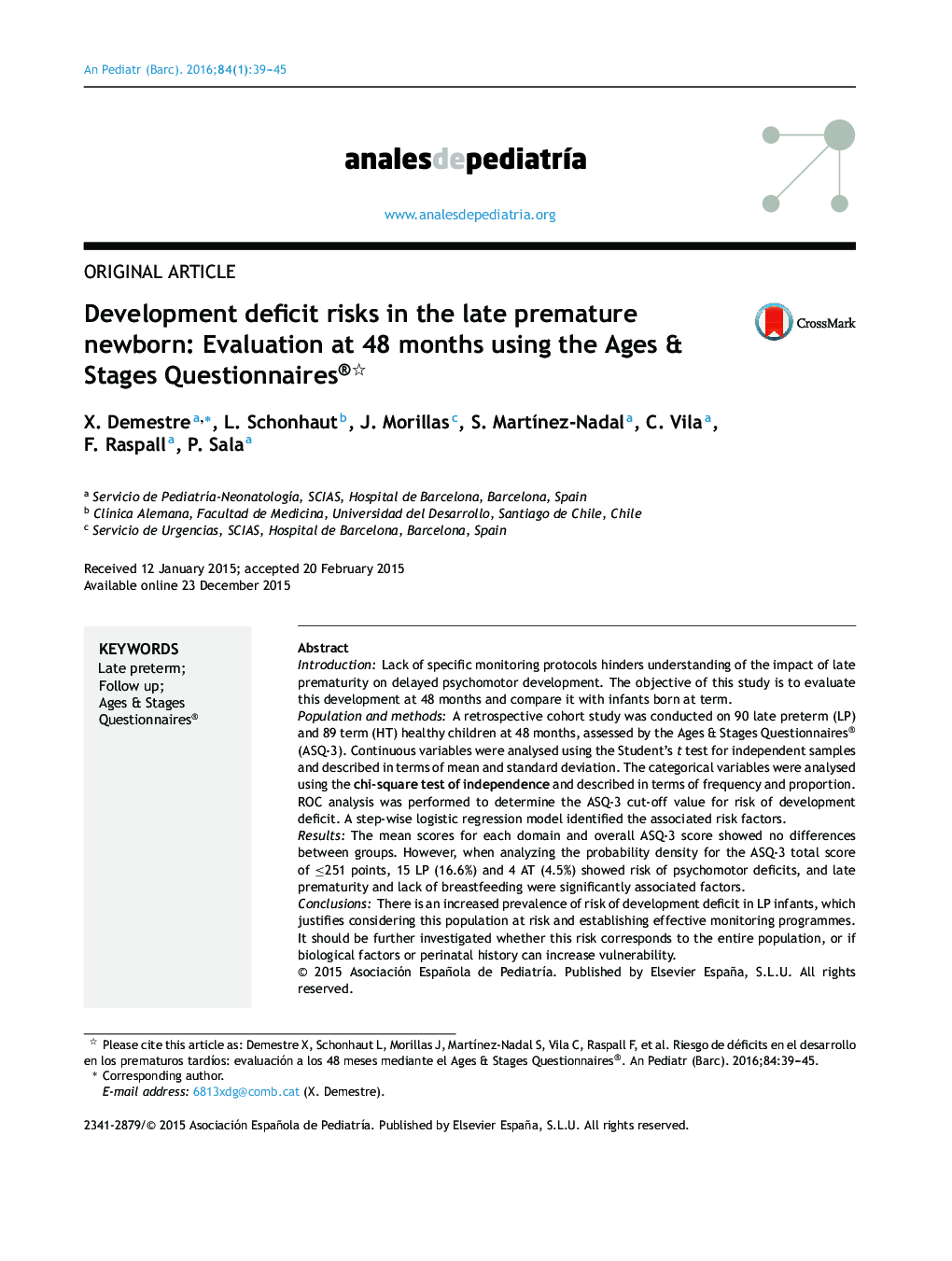| کد مقاله | کد نشریه | سال انتشار | مقاله انگلیسی | نسخه تمام متن |
|---|---|---|---|---|
| 4145094 | 1272586 | 2016 | 7 صفحه PDF | دانلود رایگان |
IntroductionLack of specific monitoring protocols hinders understanding of the impact of late prematurity on delayed psychomotor development. The objective of this study is to evaluate this development at 48 months and compare it with infants born at term.Population and methodsA retrospective cohort study was conducted on 90 late preterm (LP) and 89 term (HT) healthy children at 48 months, assessed by the Ages & Stages Questionnaires® (ASQ-3). Continuous variables were analysed using the Student's t test for independent samples and described in terms of mean and standard deviation. The categorical variables were analysed using the chi-square test of independence and described in terms of frequency and proportion. ROC analysis was performed to determine the ASQ-3 cut-off value for risk of development deficit. A step-wise logistic regression model identified the associated risk factors.ResultsThe mean scores for each domain and overall ASQ-3 score showed no differences between groups. However, when analyzing the probability density for the ASQ-3 total score of ≤251 points, 15 LP (16.6%) and 4 AT (4.5%) showed risk of psychomotor deficits, and late prematurity and lack of breastfeeding were significantly associated factors.ConclusionsThere is an increased prevalence of risk of development deficit in LP infants, which justifies considering this population at risk and establishing effective monitoring programmes. It should be further investigated whether this risk corresponds to the entire population, or if biological factors or perinatal history can increase vulnerability.
ResumenIntroducciónLa ausencia de protocolos específicos de seguimiento dificulta el conocimiento de la repercusión de la prematuridad tardía en el desarrollo psicomotor. El objetivo es evaluarlo a los 4 años y compararlo con los nacidos a término (AT).Población y métodoEstudio de cohortes retrospectivo de 90 prematuros tardíos (PT) y 89 AT sanos, a los 48 meses, evaluados mediante el Ages & Stages Questionnaires® (ASQ-3). Las variables continuas se describen mediante media ± DE comparadas con el test de la t de Student para muestras independientes; las variables categóricas, mediante frecuencias y proporciones, comparadas con el test de independencia de la chi al cuadrado. Se determinó un punto de corte para la puntuación total del ASQ-3 capaz de discriminar el riesgo de déficit del desarrollo mediante un análisis ROC. Una selección step-wise para el modelo de regresión logística determinó los factores de riesgo asociados.ResultadosLas puntuaciones medias de cada dominio y de la puntuación global del ASQ-3 no mostraron diferencias entre ambos grupos. Sin embargo, al analizar la densidad de probabilidades para la puntuación global del ASQ-3 ≤ 251 puntos, 15 PT (16,6%) y 4 AT (4,5%) mostraban riesgo de déficit psicomotor, y la prematuridad tardía y la ausencia de lactancia materna resultaron factores asociados significativamente.ConclusionesHubo una mayor prevalencia de riesgo de déficit en el desarrollo en los PT, lo que justifica considerar esta población de riesgo y establecer programas de seguimiento eficientes. Debe seguirse investigando si este riesgo corresponde a toda la población o si existen factores biológicos o antecedentes perinatales que los hacen más vulnerables.
Journal: Anales de Pediatría (English Edition) - Volume 84, Issue 1, January 2016, Pages 39–45
